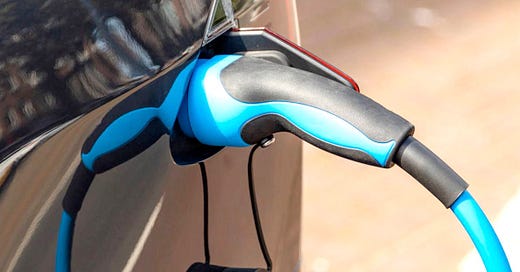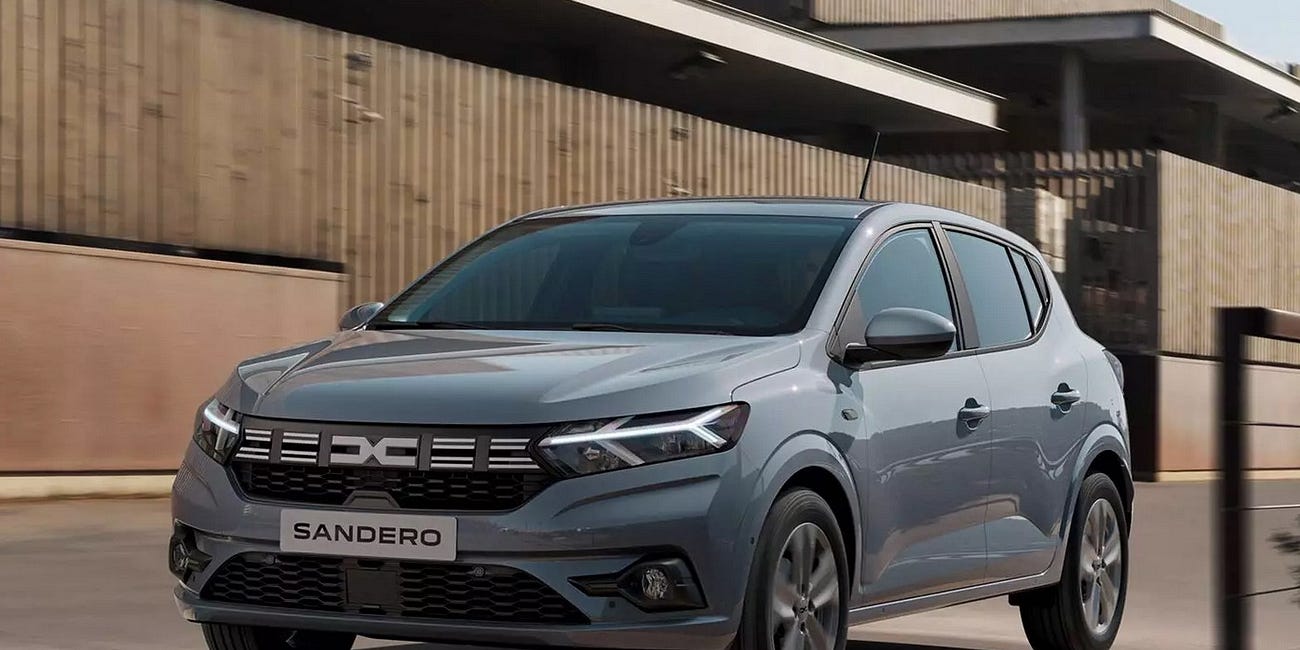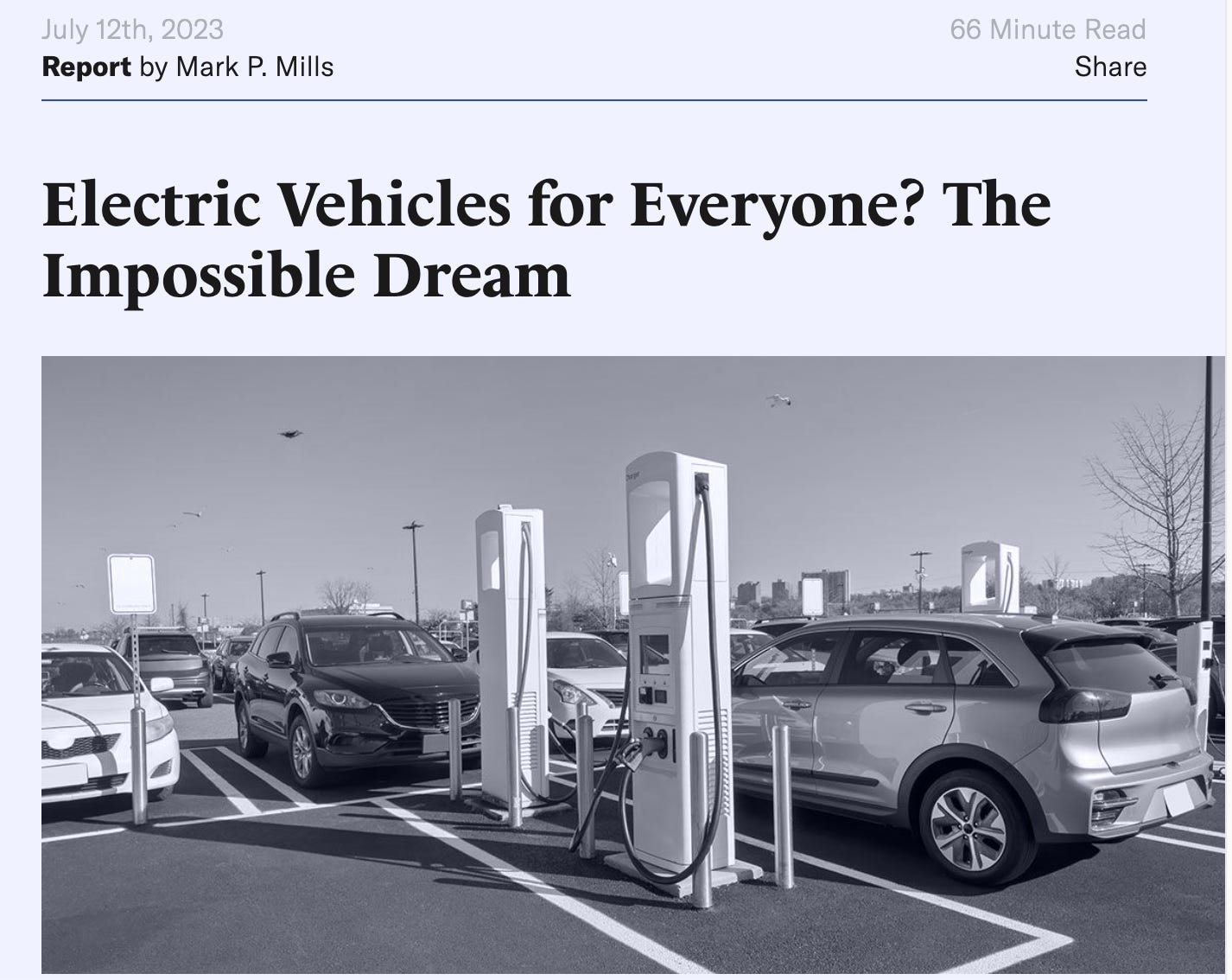Are Electric Vehicles a Solution? Executive Summary
Let’s summarize here the key points of our analysis, which shows that there is little rationale for any massive & rapid transition towards electric vehicles.
We summarize here the key points of our analysis. The full analysis is found in the article’s Part 1 & Part 2. We have also a piece about range anxiety. A French version of this executive summary is available here.
There is presently a massive push in many countries, in the EU, North America and elsewhere, to increase the number of electric vehicles (EVs) and to progressively phase out internal combustion engine (ICE) vehicles. This massive push relies on massive subsidies, stringent regulations and sometimes protectionist measures, as EVs presently are not cost competitive and are far from offering the same convenience and driving qualities as ICE vehicles, such as long range, rapid fueling time, good affordability, to name just those.
This analysis was done with an open mind, independently, not trying at the start to reach a particular conclusion. The analysis by Mark Mills in his recent study, that led him to conclude that EVs are essentially an “impossible dream,” needed to be looked at very seriously, as his conclusions are so much at odds with what governments, spending / wasting billions and billions of taxpayers money, are now doing in so many countries to push EVs.
The core argument used to justify a transition to electric vehicles is that it will have a positive effect regarding climate change. In a nutshell, their logic is as follows. ICE powered vehicles generate CO2 emissions, which contribute to warm up the climate, and limiting those CO2 emissions will help mitigate such warming. For those who don’t believe in that theory, the transition to EVs does not make any sense. What is found in the article is that, even if one assumes anthropogenic carbon emissions play an important role regarding climate change, the findings of the analysis are the same as if you are a climate change skeptic. So please keep on reading, whatever your stance is on the link between CO2 and climate change.
Despite all the rhetoric, EVs are NOT zero CO2 emissions vehicles. This naïve, myopic, perspective is found a bit everywhere to justify a transition to EVs, but it is plain false. The only honest way to look at EVs is to take a cradle to grave approach, and look at the emissions required for their manufacturing, for minerals extraction, for generating the electricity required to power them, etc. And to do the same with ICE vehicles, and then compare. With such approach, it’s immediately clear that EVs offer at best a small advantage. But with highly efficient ICE vehicles, this small advantage vanishes, as the EVs are then found to emit more CO2, not less.
Today, there are very low emission vehicles that are already produced, with diesel, gasoline and hybrid engines. Most car manufacturers already have the technology for such highly efficient ICE vehicles. If adopted much more widely, such highly efficient ICE powered vehicles can dramatically reduce emissions without any need to transition towards EVs, and without any need for immense and extremely costly changes in the transportation, automotive and energy sectors. It becomes then absolutely unnecessary to operate a transition to EVs.
There are several comparisons between EVs and ICE vehicles that have been made, and Part 2 of the article looks at some of them closely. These comparisons are very instructive to understand the major problems associated with electric vehicles, both at the individual and the public policy levels. First, when you get your new EV, there are considerable CO2 emissions that already have been generated to produce your vehicle, and they are much higher than those associated with the production of a comparable ICE vehicle. The idea that buying an EV is a kind of ecological act, from a CO2 / climate perspective, is plain false. The virtue signalling, by some, when they purchase an EV is accordingly plain ridiculous.
Second, the studies show that it will take at least several years, typically at the very minimum 4 or 5 years, for the EV to have net lower emissions than a comparable ICE powered vehicle. In some instances, it will take much longer, or it may actually never happen. Yes, depending on key factors, which we will review, your EV may or may not generate any net CO2 emission savings. For example, when the car is not driven a lot, or when the EV is compared to a highly efficient ICE vehicle, there is then no scenario where any significant net CO2 emissions savings can realistically be achieved.
Third, the energy mix of the electricity used to power the EV is critically important to assess the CO2 emissions it generates while driving. Energy mixes vary throughout the world, yet remain largely dependent on coal and fossil fuels in general. Some European countries, notably Germany, are dropping nuclear, thereby increasing the CO2 emissions from their energy mix. In most cases (Northern Europe, Northern USA, Canada, etc.) solar and wind are and will remain incapable to meet the increased electricity demand linked to EVs. In countries with coal representing a high share of the energy mix, such as Poland, China and India, it’s virtually impossible for EVs to induce any benefits in terms of CO2 emissions.
Fourth, your annual driven mileage is important. If you don’t drive your EV a lot, which can actually be very normal, for example for a second car in a household, then you will never breakeven and achieve any CO2 savings. Why? It’s simply because of the large excess CO2 emissions associated with the manufacturing of the EV, particularly its battery. From an incentives perspective, this means that your natural inclination to avoid driving too long distances, if you can avoid it, will actually go against the whole idea of your EV to generate net CO2 emissions savings over the vehicle’s life.
Fifth, the three comparisons reviewed in the article, even if very instructive, share a common, major, flaw. They compare in each case an EV with a comparable ICE powered car that actually is not the most efficient one available. In the VW Golf comparison, for example, a Golf EV model is compared to a Golf gasoline model, with a consumption of 5.2 litres / 100 km. But if the comparaison had been made instead with the Golf 8 2.0 TDI diesel model, with a 3.5 litres / 100 km consumption, achieving 67 MPG, the results would have been much much worse for the EV. If you drive one of the most efficient ICE powered vehicles, it’s virtually impossible for any EV to beat it in terms of low CO2 emissions.
As in the 19th Century, when the first EVs emerged, the Achilles Heel of the electric vehicles remains the batteries. They have a very low energy density - about 100 times lower than with gasoline or diesel, and they require immense mining and energy to be produced and manufactured. A standard 1,000 pounds / 450 kg battery requires a staggering ~100,000 pounds or 45 tons, of ore, from minerals such as lithium, cobalt, nickel, graphite, copper, steel and aluminum. Large quantities of chemicals to process and refine the ores are also necessary. Some SUV batteries actually have three times that weight, requiring three times this already considerable mining.
The article does not delve into the details of the negative environmental and social impacts of such mining, but they are immense. For example, in the Congo, which is the world’s main cobalt producer, there is a horrific reality of mines where very young children and adults work, in miserable and unsafe conditions, for some 2 dollars per day. The environmental impacts of mining are also considerable. For example, with lithium, huge amounts of water are needed, with devastating impacts on ecosystems and on local agricultural producers. Things may get much worse, as the richest mines get progressively depleted and the newer ones are typically less rich and require even more ore to be extracted for producing the same quantity of refined mineral. Also stressed in the Mills report is that the mining industry is unable to respond to this considerable rapid increase in demand for minerals associated with EVs, which will likely mean shortages and higher prices for the key minerals needed to manufacture EV batteries.
One of the most important, yet most problematic, ingredients of EV batteries is lithium. Why? Not only because its cost and relative rarity, but because it is associated with the spontaneous fires that EVs are, maybe rarely, but too regularly, subject to. These fires, which also occur with e-bikes for example, are typically impossible to extinguish, lead to a complete loss of the vehicle, and can also inflame other vehicles or nearby buildings. Parking an EV in a building is increasingly seen as a hazard. The situation is so serious that there are calls, for example by the Commissioner of the NY Fire Department, for making the batteries, from EVs, e-bikes, etc. much safer. But it’s not clear if that is technically possible with lithium based batteries.
Transitioning to electric vehicles poses an immense industrial problem. Many industrialized countries have very well established, efficient, ICE car industries. Transitioning to more efficient ICE vehicles is easily feasible and has actually already been achieved by most manufacturers, at least for some of their models. But transitioning to EVs is much more problematic. Why? EVs are more expensive, which brings people to seek smaller cars. High labor cost countries are typically unable to compete with low cost producers, especially China, for such smaller vehicles. With countries like France, the UK, Germany, Italy and the USA less able to compete, this leads to a de-industrialization in the automotive sector. This is especially the case in Europe, that has been hit by sharp energy prices increases in the past years and is facing gloomy years to come as far as industrial energy prices are concerned.
Of course, industrialized, high labor cost, countries want to participate in the new EV economy. It sounds so great. It looks so popular, so ecological. What do governments then decide to do? They introduce regulations, subsidies and even protectionist measures to promote the EV sector. This is of course anathema with good economic practices. An example of a massive yet very questionable governmental intervention is a C$ 13.2 billion public aid to be provided in Canada to an EV battery factory by VW to be built in Ontario. As an estimated 80% of the cost of EV batteries is typically constituted by the needed minerals (cobalt, lithium, etc.), such factory only generates some 20% of the added value, which is low and offers little interest from an economic development perspective. Yet, the offered subsidies are massive and represent a whopping C$ 4.4 million per job created. This does not make any sense, yet such low value added investments can be expected to flourish in many jurisdictions pushing this transition to EVs, even if they are very costly and a terrible use of taxpayers money.
Moreover, several manufacturers in industrialized countries are now betting on heavy, luxury, electric SUVs, trucks, etc. Why? Because these are much more expensive models, that can justify higher labor costs. These vehicles require however massive energy to be produced and to be powered, with typically massive batteries. This is not a positive trend from an environmental, CO2 emissions, electricity availability, angle. Again, opting for the most fuel efficient versions of such vehicles will likely be a much better option, and avoid all the issues associated with the EV versions, such as high cost, limited range, long charging time, insufficient power available from the grid, etc.
Are the low fuel consumption, high MPG, internal combustion engine vehicles clean enough to be promoted as alternatives to the EVs? Absolutely yes. The Ultra Low Emission Zones (ULEZ) already implemented in London and other UK cities do accept a variety of vehicles: electric, hybrid, gas or diesel powered. The ULEZ rely on European standards that set limits for air polluting Nitrogen Oxides (NOx) and particulate matters from engines. Most recent car models do meet the standard. Only older models are problematic. The ULEZ standard does not deal with CO2 emissions, but among the models that meet the ULEZ standards, there are already many low consumption, high MPG vehicles, with very low CO2 emissions. To be noted is that recent research has shown that the particulates originating from tyres are much higher than those emitted from exhausts. So, EVs also produce lots of particulates from their tyres, much more than those originating from a diesel or gasoline powered car exhaust.
Generally speaking, even if there has been considerable improvement since the first electric vehicles in the 19th century, electric vehicles remain much less convenient; have much lower range; require much longer times to fuel them, are way more expensive, do last less both in terms of driven distances and years (if the battery life is taken into account), and have an increasingly recognized serious fire hazard. EVs only have a few, minor, qualities over ICE powered vehicles, such as lower noise and usually better accelerations. As far as the lower electricity price to charge them, compared to gas or diesel, this is typically artificial, as resulting from different levels of taxes on electricity, gasoline and diesel. In many countries, electricity prices are sharply on the rise. And this rise can only be accelerated by the increasing power demand on the electric grid created by the growing number of EVs.
As we have seen, there are already options, other than EVs, to get passenger vehicles to have a much lower footprint and emit less CO2 than today. And contrary to EVs, there are no significant hurdles for the automotive industry to increase the production of highly efficient ICE models. That so many governments choose opting for the EV route is baffling, as there are so many issues associated with them, and as they are not even effective at reducing CO2 emissions. Governments, however, seem to be all in this non-solution, and proceed with generous subsidies, stringent (unrealistic) regulations and sometimes protectionist measures. The prohibition to sell non-electric vehicles in the EU by 2035 is an example of such absurd regulation, as the most efficient ICE cars, emitting much less CO2 than their EV counterpart, will be prohibited. This is bad, uninformed, public policy, which will have immense negative consequences for the population, and requires urgent correction.
From this analysis, there is a pretty simple conclusion. With the technology available today, absolutely nothing justifies a massive, rapid, transition to electric vehicles. If the goal is to reduce CO2 emissions, there are much more efficient and cheaper ways to achieve this, simply by incentivizing low CO2 emitting vehicles and disincentivizing high CO2 emitting vehicles. This can be done easily, with negligible public expenditures, without creating unnecessary and irreparable havoc in the transportation, automotive and energy sectors for the decades to come.
Oh, I forgot … “let that sink in” !! :)
And please share and subscribe.
If you haven’t done so, you are invited to read Part 1 and Part 2 of this article, a subsequently added post about range anxiety, as well as Mark Mills’ recent report entitled ““Electric Vehicles: The Impossible Dream.” A Part 3 of this article is to be published later, as a few important aspects have not been covered in parts 1 & 2. Yet, the key policy findings and conclusions will not change, as the most critical aspects have already been covered.
Electric Vehicles: Are They Really a Solution? — Part 1
Update: Part 2 of the article is now available here. It may be challenging, but I will share some thoughts about electric cars, a topic that was brilliantly covered in a new study issued by the Manhattan Institute, titled “Electric Vehicles for Everyone? The Impossible Dream,” authored by Mark P. Mills.
Electric Vehicles: Are They Really a Solution? — Part 2
As we already discussed in Part 1, despite all the rhetoric, there is no such thing as zero emissions vehicles, as carbon, CO2, is generated for the manufacturing of the electric vehicles as well as for generating the electricity to power them. Let’s immediately stress a critical point. When you purchase an electric vehicle, you actually induce, through…
EV Range, Anxiety & More …
A post specific to range was not planned in the context of this analysis of electric vehicles, with, already published, an executive summary, a part 1 and a part 2, available both in English and French. After all, range anxiety is well known when it comes to electric vehicles. And the industry is working hard to improve ranges, we hear. So why bother?
Link: https://manhattan.institute/article/electric-vehicles-for-everyone-the-impossible-dream








EVs are NOT the solution. There is no empirical-methodical pathway to the Green New STEAL. Nobody produced that case, and more dangerous still, few have DEMANDED that absurd justification. There are at least 200M Americans that will refuse to buy anything the GOVERNMENT decides they “must” buy. Take your government solution and SHOVE IT!
Just the side by side picture of the HUGE crater created by mining for their batteries compared to gas ALONE should convince any human with an ounce of common sense it's BS! They are making EXPENSIVE throw away cars just like all technology/appliances and those ugly non degradable wind turbines with a 3 year life span! Remember...it's for your own/earth's good really means...yo @$$ will be broke and someone else's pockets will be full!